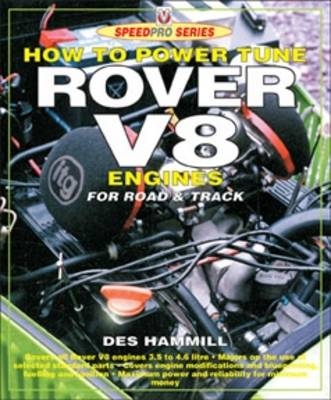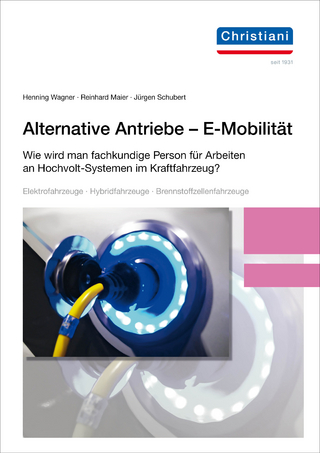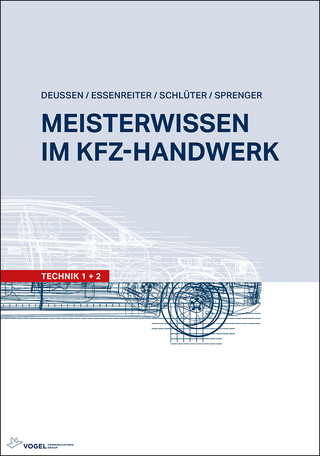
How to Power Tune Rover V8 Engines for Road-track
Veloce (Verlag)
978-1-903706-17-6 (ISBN)
- Titel erscheint in neuer Auflage
- Artikel merken
Des Hammill is a professional engineer with huge experience of building successful and reliable racing engines and solving the problems associated with all aspects of high performance applications. Des has written many of Veloce's SpeedPro series books.
Using this book & Essential information 7 Introduction 9 Buick & Oldsmobile engines 10 Rover engines 12 TVR Tuscan engines 12 Leyland P76 engines 12 Chapter 1: Cylinder block, liners, pistons & timing chain 14 Cylinder block types 14 Type 1: 1967 to 1980 3.5in bore P5, P6, Range Rover and early SD1 blocks 15 Type 2: June 1973 to December 1980 Australian-made Leyland P76 engine (4.4 litre) 16 Type 3: 1980 to 1993 3.5in bore uprated stiff block 16 Type 4: October 1989 to December 1993 3.9 litre engines 17 Type 5 & 6: January 1994 onward 3.9 & 4.2 litre interim engines 18 Type 7: September 1994 onward 4.0 & 4.6 litre 38A block engines 20 Type 8: 1995, 1997/1998 3.5 litre service engine blocks 22 Quick reference block identification 23 Which cylinder block to use? 23 Wildcat modified blocks 26 Water loss problems caused by block cracking 29 Symptoms 30 Repairing cracked blocks 31 Standard blocks 32 Two bolt main cap blocks 32 Two bolt main cap problems 33 Stud & nut kits for two bolt main caps 37 Camshaft bearings (all blocks) 39 Timing chain (all blocks) 40 Engine block requirements for high performance 41 Fitting a camshaft thrust plate to pre-1994 engine blocks 41 Teflon-faced thrust bolt 43 Oversized cylinder liners for 3500cc blocks 44 Standard cast pistons 45 Standard piston sizes 46 Hypoeutectic, eutectic & hypereutectic cast pistons 46 Forged pistons 47 Bore wear 47 Summary 48 Cylinder bore preparation 48 Cylinder head fixings 50 Chapter 2: Cylinder head identification 51 Identification 51 Buick heads 51 Original Rover 3.5 litre heads 51 First change: SD1 & Range Rover heads 1976 on 51 Second change: 1982 on 53 Third change: 1982 on 53 Fourth change: 1993 on 53 Fifth change: 1994 on 54 Early heads & unleaded fuel 55 Valves 56 Valve spring & valve spring retainers 56 Standard inlet & exhaust ports 56 Chapter 3: Distributor, front cover & oil pump identification 57 Distributors 57 Car distributors 57 4X4 & commercial vehicle distributors 58 Front covers 58 Type 1 & 2 58 Type 3 58 Type 4 59 Types 5 & 6 59 Type 7 59 Type 8 60 Gear-driven oil pumps 60 Water pumps 60 Camshaft skew gears 61 Buick versus Rover skew gears 61 Adjustable oil pressure (crank-driven oil pump-type front covers) 61 Chapter 4: Distributors & ignition timing 62 Lucas distributors 62 Repair 63 Mechanical advance system 63 Changing static advance setting 63 Changing the rate of advance 63 Vacuum advance system 64 Racing engines 64 Vacuum advance on racing engines 64 Mallory distributors 65 Repairing 65 How dual points work 65 Dual points reliability 66 Adjustable mechanical advance 66 Changing amount of static advance 66 Changing rate of ignition advance 66 Road cars 67 Racing 67 Conclusion 67 True TDC 67 Degree marking the crankshaft pulley rim 67 Ignition advance 68 Stroboscope ignition timing 68 Too much compression 69 Standard sparkplug leads (wires) 69 Sparkplug lead location 69 Condenser 69 Further reading 69 Chapter 5: Rocker arms, rockershaft & pushrods 71 Rocker arm geometry 71 Rockershaft height 72 Roller rockers 73 Hydraulic lifter preload 73 Shorter pushrods 74 Standard rocker arms 74 Standard rocker arms & shaft with high lift camshaft 75 Chapter 6: Camshafts & valve springs 77 Camshafts with standard valve lift 77 Camshaft choice 78 Standard camshafts 78 Regrinds 78 Aftermarket camshafts 78 Valve springs & retainers 79 Hydraulic lifters 79 Using old lifters 80 Common problems 80 Camshafts for 'Group A' racing 81 Summary 81 Increasing valve lift above standard 81 Early cylinder heads 82 1976-1993 cylinder heads 82 1993 on cylinder heads 83 Valve springs for high performance applications 85 Standard single valve springs 85 Aftermarket valve springs 85 Which aftermarket camshaft? 87 The consequences of higher valve lift 88 High performance aftermarket camshafts 88 Smooth idle' camshafts 88 'Rough idle' camshafts 89 270-280 degree camshafts 90 280-290 degree camshafts 90 Long duration (295-305 degrees plus) 91 Alternative profiles & phasings 91 Summary 91 Chapter 7: Balance 92 Original factory engine balance 92 Engine balance for high performance 93 Chapter 8: Lubrication 95 Low oil pressure 95 Improving oil systems of non-crank-driven oil pump engines 96 Increasing oil pressure 96 Oil pump 97 Pressure relief valve 99 Extra oiling of the distributor & camshaft skew gears 100 Camshaft bearing modification 100 Dual oil feed to the centre three main bearings 100 360 degree main bearing oiling 101 Crankshaft bearing clearances 101 Lifter to lifter bore fit 102 Adjustable oil pressure relief valve: crank-driven oil pumps 102 Improved main & big end bearing oiling (all engines with standard crankshaft oilways) 102 260-270 degree main bearing oiling 102 Altering standard bottom main bearing shells 103 Big end bearing oiling improvement summary 104 Radiusing crankshaft oilways 104 Restricting rockershaft oil feed (all engines) 104 Wet sump (oil pan) 105 Crankcase ventilation 107 Chapter 9: J.E. Developments & other specialists 108 J.E. Developments 108 Cylinder blocks 108 Crankshafts 109 Connecting rods 110 Special capacities for racing applications 111 Other racing engine capacities 112 Cylinder heads 112 Valve set 1 112 Valve set 2 112 Valve set 3 112 Valve set 4 113 Valve springs 114 Camshafts 115 Valve train 116 Engine balance 118 Ignition systems 119 Induction systems 119 Optimum fuel mixture settings 120 Fuel 120 Exhaust systems 121 Other specialists 121 Chapter 10: Wildcat Engineering 122 Wildcat Engineering 122 Connecting rods 123 Crankshafts 124 Maximum bore (up to 6000cc) Rover V8 competition engines 124 Crankshaft dampers 126 Turbo block 126 Cylinder heads 127 High performance cylinder heads 128 Stage 1 cylinder heads 130 Stage 2 cylinder heads 130 Inlet manifolds 132 Fuel injection throttle bodies 133 Dry sump system 133 Steel flywheels 134 Wildcat engine example 134 Chapter 11: Cylinder head modifications 136 Which heads? 136 Modifications 137 Preparation 137 Valve guides 137 Minor porting 137 Valve seats 138 Refacing 140 Fully modified cylinder heads 140 Chapter 12: SU carburettors 148 Setting up 148 1) Float levels 148 2) Needle heights 149 3) Main jet heights 149 4) Idle adjustment screws 149 5) Balance 149 6) Idle mixture 149 7) Synchronising butterflies 150 Fuel pressure 150 Emission control poppet valves 150 Crankcase breather 150 Air cleaners & ram pipes 150 Changing & modifying needles 151 Standard needles 153 Needle tuning 154 Modifications for racing 155 Chapter 13: Holley carburettors 156 390-CFM vacuum secondary with automatic choke 156 Setting up 156 1) Float levels 156 2) Idle adjustment screw 156 3) Accelerator pump 157 4) Idle adjustment screws 157 5) Metering block 157 390-CFM mechanical secondary ( double pumper ) four barrel 158 Tips (all Holley carburettors) 158 1) Float levels 158 2) Fuel pressure 158 3) Backfiring through the carburettor 158 4) Fuel spillage 158 5) Gaskets 158 6) Butterfly opening 159 7) Fuel filter 159 8) Accelerator pump 159 Summary 159 Air filters 159 Fuel filters 160 Fuel pumps 160 Chapter 14: Inlet manifolds 161 Inlet manifolds for Holley carburettors 161 180 degree manifolds 162 Low rise 162 High rise 162 Aftermarket 180 degree manifolds 163 360 degree manifold 163 Summary 164 Other downdraught carburettor options/adaptors 164 Standard & aftermarket inlet manifolds for SU carburettors 164 Chapter 15: Fuel injection & engine management systems 166 L-Jetronic 4CU fuel injection system (USA & Australian types 1974-1990): overview 166 L-Jetronic 4CU fuel injection system (UK type 1983 to 1990): overview 167 L-Jetronic 4CU fuel injection system: operation 168 ECU (electronic/engine control unit) 168 Airflow meter 168 Airflow meter: setting 169 Throttle body potentiometer 170 Throttle body potentiometer: setting 170 Fuel delivery control 170 Fuel supply system 171 Cold start controls 172 Lambda sensors 172 Ignition system 172 L-Jetronic 4CU fuel injection system: early methods of modification for high performance 173 Airflow meter: altering setting 173 Fuel pressure: increasing 174 Temperature feedback: altering 174 Conclusion 174 L-Jetronic 4CU fuel injection system: current methods of modification for high performance 174 Injectors 174 ECU upgrade 175 Airflow meter 176 Rising rate fuel pressure regulator 176 4.2 litre upgrade 177 Twin plenum L-Jetronic 4CU fuel injection system 178 Twin plenum L-Jetronic 4CU fuel injection system: twin airflow meters 179 L-Jetronic 13CU and 14CU electronic fuel injection system: overview 179 L-Jetronic 14CUX electronic fuel injection system: overview 180 Injectors 180 ECU 180 Airflow meter 181 GEMS 8 integrated engine management system: overview 182 GEMS 8: methods of modification for high performance 184 GEMS 8: ignition system 186 Bosch Motronic ML.2.1 engine management system: overview 187 HT (High Tension) lead/wire requirements (all systems) 187 Catalytic converters (all systems) 187 Chapter 16: Exhaust system 189 Original exhaust manifolds 189 Tubular exhaust manifolds (headers) 190 4 into 1 190 4 into 2 into 1 192 Pipe dimensions 193 Pipe dimensions 194 Sealing exhaust manifolds 194 Chapter 17: Cooling system 195 Kit cars 196 Radiator 196 Thermostat 196 Fan 196 Pipework 196 Racing cars 197 Optimum temperature range 197 Radiator 197 Restrictor plate 197 Selecting & fitting a radiator 197 Radiator caps & header tanks 197 Water pump speed 199 Swapping pulleys 200 Other options 200 Chapter 18: Flywheel & clutch 201 Flywheel 201 J.E. Developments dry sump system flywheel 201 Clutch 202 Chapter 19: Rolling road dyno 203 Chart A 206 Chart B 206 Conversion chart 207 Index 213
| Erscheint lt. Verlag | 4.8.2005 |
|---|---|
| Reihe/Serie | SpeedPro Series |
| Zusatzinfo | 182 colour illustrations |
| Sprache | englisch |
| Maße | 207 x 208 mm |
| Themenwelt | Sachbuch/Ratgeber ► Natur / Technik ► Fahrzeuge / Flugzeuge / Schiffe |
| ISBN-10 | 1-903706-17-3 / 1903706173 |
| ISBN-13 | 978-1-903706-17-6 / 9781903706176 |
| Zustand | Neuware |
| Haben Sie eine Frage zum Produkt? |
aus dem Bereich


